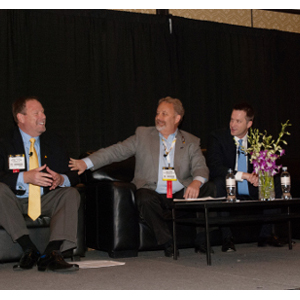
|
| Panelists Christ Staniforth, Larry Newman and Eric Yunag discussed ways companies can ensure the people they hire will be the best fit for their organizational culture. |
The level of success any organization is able to achieve depends largely on the quality of its employees, making hiring and retaining the right employees critical. And while it may seem that qualifications would be the best measure of how an individual will perform within the organization, the evaluation process for potential employees must go much deeper than their resume.
This was the recurring theme of yesterday’s State of the Industry session, titled “Talent Management: Best Practices for the Security Industry.” Moderator Rebecca Bayne of BCSI/Bayne Consulting and Search Inc. led panelists Larry Newman of Axis Communications, Chris Staniforth of ALC Consulting Inc. and Eric Yunag of Dakota Security Systems through a discussion of how best to identify, hire and retain those employees who will ultimately be the best fit for an organization. All agreed that while a resume is a good indicator of an individual’s skills, how that person’s core values align with the organization’s core values is equally important – if not more so.
“It’s important to have a hook to attract employees to your company,” Staniforth said. “One mistake organizations make is to identify people by the company they work with rather than looking at personal characteristics like work ethic and initiative.”
Much of the discussion centered on the role of organizational culture in the hiring process, namely how to define those core values, figure out which are most important and decide how to determine what defines a “good fit” in potential employees.
“We want to make sure we’re vetting people well, finding things that don’t show up on a resume or in an interview conversation,” Yunag said.
The first step in the hiring process, however, is to ensure that it is an actual process – one that is consistent, clear and repeatable – to ensure that candidates are evaluated using the same criteria.
“A lot (of the hiring process) has to do with the structure and the people, having a plan and setting expectations,” Newman said.
When it comes to criteria, the more factors that play into the evaluation process, the better, and that data could come from a number of sources, including personality assessments, background checks and reviewing a candidate’s social media activity.
“We want to quantify as many data points as possible,” Yunag said. “There’s more of a focus on who they are, not just their skills. You can teach skills but you can’t change who a person is.”
It’s OK to make mistakes in hiring and retention, as long as you learn from those mistakes. Yunag said Dakota Security made its share of mistakes early on, many of which can be attributed to not placing greater importance on cultural aspects, but that those mistakes have helped shape what is now a much more comprehensive and effective process.
“I think a lot of growing companies make the same mistake; they focus on the resume, not the deeper culture and core values,” he said. “Today, we identify a deep level of core values in individuals to determine if they’re true to themselves and whether those values match ours as accompany. If you don’t describe those values and identify them in people, you’re not doing the best job.”
Neglecting the role of culture in the process tends not to work out very well, Newman said.
“Every time we’ve stepped out of that culture, 90 percent of the time we failed to find the right person and had to cut our losses,” he said. “We’ve definitely learned more from our failures than from our successes.”
In addition to more advanced or technology-based criteria and methods, sometimes good old-fashioned gut feelings play a significant role in hiring decisions.
“In the most successful organizations, managers rely on their gut. If you’re hiring to fill a position and don’t rely on your gut, six months down later, you may learn that a person is not going to work,” Staniforth said.
Hiring is just one side of the equation. Once a new employee comes on, the ongoing process of retaining that employee kicks in. In what Staniforth described as a candidate-driven market, employees and potential employees may find themselves tempted by job offers from competitors or even former employers. Whether they’re a long-time employee or a new hire and regardless of how they feel about a company or industry, if a person doesn’t feel welcome and respected, or if there are no clear opportunities for advancement, those offers become very attractive options. More often than not, people don’t leave their jobs because of money, but rather because they just didn’t feel right – and a lot of that has to do with their interactions with supervisors and other employees.
“When I get calls from people looking for a new job, they’re not saying, ‘I hate the company’ or ‘I hate IP cameras.’ What they say is ‘I hate my boss.’ You have to make employees feel like an important part of the company,” Staniforth said.
Training, mentoring and professional development can play quite a role in employees’ decision to stay with a company.
“The message has to be that you don’t have to leave your job to learn more,” Bayne said.



